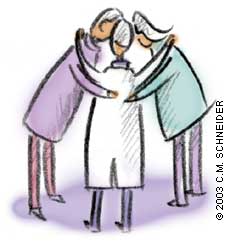
Wise utilization of your nursing staff will improve efficiency, patient care and your bottom line.
Fam Pract Manag. 2003;10(2):51-52

In a climate of rising expenses and declining reimbursement, how you use your nursing staff can make or break your practice. Support staff costs comprise between 25 percent and 43 percent of revenue for primary care practices, according to the Medical Group Management Association, and nursing staff can represent a significant portion of these costs.1 However, in many practices, nurses are not fully optimized; they waste time on tasks that should be delegated to lesser-skilled staff, while physicians waste time on tasks that should be delegated to the nurses. By finding ways to employ your nurses to their fullest potential, you can not only boost your bottom line but also improve overall efficiency and provide better patient care. Here’s how.
Look for more efficient methods
To determine how your nursing staff might be better utilized, consider the following ideas:
Eliminate nurse interruptions. Examining why your nurses interrupt you throughout the day can tell you a lot about your nurses’ abilities and where they might need further training or feedback. How frequently do your nurses interrupt you during the day? What is the nature of the interruptions? How long are the interruptions? And what time of day do they generally occur? For example, if one of your nurses is habitually interrupting you with triage questions, perhaps you could equip the nurse with better triage guidelines – or eliminate triage altogether (more about that later).
Reduce telephone calls and messages. Categorize your phone messages into two groups: 1) those that could have been taken care of by a nurse and 2) those that specifically required your intervention. Take the time to meet with your nurse to discuss and design guidelines for handling phone messages more efficiently.
Ask your nurse to examine his or her telephone calls as well, documenting the quantity, type and duration of calls received in one week. How many of these calls could have been prevented or delegated to another individual within the practice? How many calls were from patients who had been seen by the physician within the previous 48 hours? What type of information are these patients requesting that could have been communicated directly to the patient at the time of the visit?
Rethink your intake process. How much redundancy is there between what you do when you enter the exam room and what the nurse does at the beginning of each visit? Consider moving the nurse’s role to the end of the visit, and have the nurse do an “exit interview” to ensure the patient has closure.
Stop searching. How often do you have to look for forms or supplies or wait for your nurse as he or she searches for these things? If all of your exam rooms are identical and stocked in the same manner, and if the intake process is consistent throughout the practice, you and your nurses will be able to work more efficiently. Consider posting a standard list of supplies for each exam room and set reorder points so you order on time and never run out of supplies.
Take a hard look at the nurse triage function. What percentage of patient phone calls to your practice result in an appointment? If the large majority of patients end up securing an appointment, why bother with triage at all? Instead, consider eliminating the triage step and simply give every patient who calls an appointment. Additionally, track how frequently the front desk staff, nurse, physician and patient actually connect on the first try during the triage function. If the majority of patient calls require a call-back, brainstorm ways you can make your process more efficient, such as having a dedicated triage nurse.
Begin each day with a huddle. A team huddle is simply an opportunity for you, your nurses and other staff to discuss the day’s schedule, staffing levels, possible bottlenecks and potentially disruptive situations. Use the start of the lunch hour to recap the morning and quickly go over plans for the afternoon. A team huddle should take no more than 10 minutes per day, but it can save you a significant amount of time due to the team working in a cohesive fashion.
Enhance opportunities for nursing revenue
To assess whether your practice is capturing all revenue opportunities, examine your physicians’ coding patterns and compare them against the patterns of other physicians within the practice or against national benchmarks, such as those published by the Centers for Medicare & Medicare Services. (See “An Easy Way to Analyze E/M Coding for Group Practices,” FPM, July/August 2002, page 20.)
The most commonly missed revenue opportunity involving nurses is the 99211 visit. If your practice is not in the habit of coding 99211s, carefully review the coding guidelines and ensure that your nursing staff is appropriately trained to capture all services that are billable under the 99211 code. In general, 99211 visits involve minimal problems, such as suture removals or peak-flow-meter instruction, and do not require the presence of a physician. (See “Coding Level-One Office Visits: A Refresher Course,” FPM, July/August 2000, page 39.) Frequently, practices provide free services to their patients and do not realize missed revenue opportunities. A good benchmark to set for your practice is to attempt to provide between three and six billable nursing visits per day.
Get your nurses on your team
Your nursing staff is critical to your practice’s overall success. As you look for ways to optimize their skills, be sure to treat them well, involve them in discussions and maintain an open and objective approach. Together, you will find significant opportunities to add value to your practice.